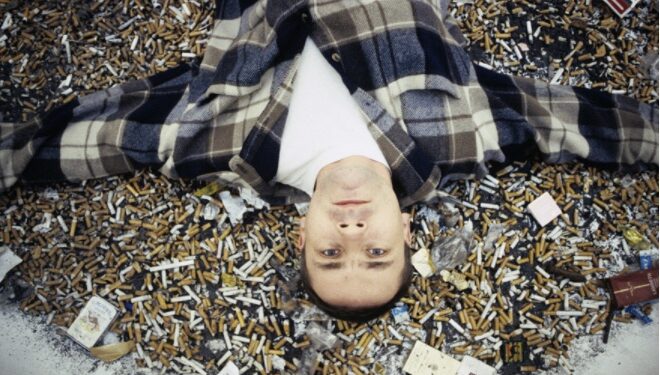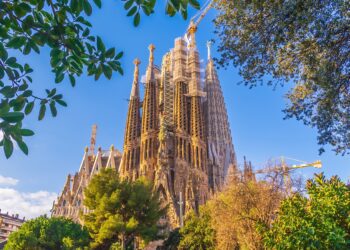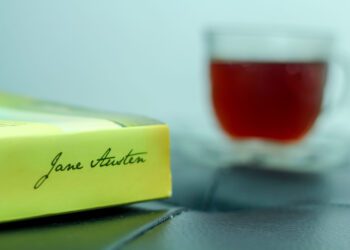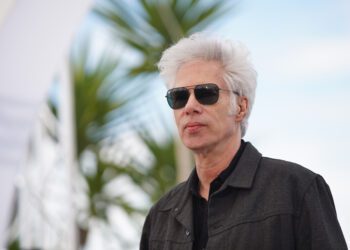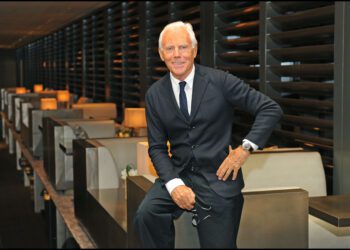With several works by Damien Hirst coming to market this March, we assess a spectacular body of work created by the headline-making artist, collector, curator and provocateur
Damien Hirst (b. 1965) — the leading light of the YBA generation and one of the world’s most successful living artists — never fails to provoke a reaction. Combining a maverick sensibility with an unerring aesthetic instinct, he has created some of the most iconic and provocative artworks of the past three decades, and in doing so has redefined the place of art in contemporary culture.
What death means to Damien Hirst
Death, and how we deal with it, is central to Hirst’s practice. ‘It’s every artist’s main theme,’ he has said. ‘There isn’t really anything else. It just depends how far you stand back from it.’
Aged 16, Hirst would draw corpses preserved in formaldehyde at an anatomy school in Leeds. ‘I wanted to know about death and I went to the morgue and I got these bodies and I felt sick and I thought I was going to die and it was all awful,’ he told his friend, the author and journalist Gordon Burn.
Hirst returned over and over again to draw the dead bodies. ‘The point where death starts and life stops for me, in my mind, before I saw them, was there,’ he explained. ‘And then when I’d seen them and I’d dealt with them for a while, it was over there again. It’s like… I was holding them. And they just were dead bodies. Death was moved a bit further away.’
The Physical Impossibility of Death in the Mind of Someone Living (1991), conceived in 1989 while Hirst was at Goldsmiths and perhaps his most infamous work to this day, sounded the keynote for his career. Suspending a 13-foot tiger shark in a vast tank of formaldehyde, Hirst confronted viewers with an audacious spectacle, exploring the human difficulty of facing our most primal fears. The work received enormous press attention when shown at the Saatchi Gallery’s YBA 1 at Boundary Road in London, and Hirst’s notoriety was secured.
The ‘Natural History’ series
The preserved shark forms part of Hirst’s ‘Natural History’ formaldehyde series, which also includes the bisected cow and calf of Mother and Child (Divided) (1993), as well as other tanks holding preserved animals such as sheep and doves, often staged in the manner of religious icons.
Many of Hirst’s grand themes are on display in these works. Influenced by the Catholic symbolism of his upbringing, they probe the relationship between science, faith and art as systems of belief, and — with their vitrines nodding to the cage-like existential frames in paintings by Hirst’s hero, Francis Bacon — the dialogue between order and chaos.
In Swimming Form in Endless Motion (1993), from Hirst’s early ‘Science for All’ series of animals preserved in acrylic tanks, a small shark appears to be travelling in a perpetual loop. The frame on which it rides has an intriguing parallel with the railings in Bacon’s After Muybridge — Woman Emptying a Bowl of Water and Paralytic Child on All Fours, which gives form to the endless cycle of life and death.
Hirst has also employed live creatures in glass tanks: A Thousand Years (1990) contains the entire life cycle of thousands of flies, which hatch as maggots from a box, feed on a severed cow’s head and are killed by an Insect-O-Cutor hanging above.
The theme of smoking appears often in Hirst’s early work. He uses cigarettes like candles in a memento mori still life to mark the passage of time, evoking the idea that life will inevitably be extinguished.
‘The whole thing in life is you don’t know when you’re going to die. It makes everything not make sense, there’s this unknown factor. Whereas if you suddenly go, “OK, I choose to die now”, you take the matter into your own hands. So smoking is the perfect way to commit suicide without actually dying,’ he once said.
Hirst changed how we think about sculpture
In the ‘Natural History’ series and beyond, Hirst’s work has fundamentally changed what we think of as sculpture. In and Out of Love (White Paintings and Live Butterflies) (1991), which sees live butterflies hatch from pupae affixed to white canvases and fly around the gallery, liberates living forms to create pattern and colour in space.
His early ‘Medicine Cabinets’ and later ‘Pill Cabinets’ transform everyday pharmaceuticals into reliquary objects of devotion.
‘Spot Paintings’ and ‘Spin Paintings’
Hirst’s impact has been no less significant in the field of painting. His ‘Spot Paintings’ and ‘Spin Paintings’ have provoked wonder and controversy alike: the former often composed by teams of studio assistants, and the latter by pouring paint onto spinning canvases. They have left some viewers incensed at the apparent mechanical coldness or randomness of their creation — which is a large part of the point of them — and others captivated by their beauty.
Butterfly, fly and insect paintings
Hirst’s paintings using butterflies, flies and other entomological specimens — whether in monochromes disrupted by iridescent insect bodies; in immense, encrusted, deathly slabs of black flies; or in stunning, mandala-like arrangements reminiscent of stained-glass windows — further his engagement with the intertwined visual languages of religion and art history, as well as his continual revisiting and reinvention of the materials of his own practice.
Treasures from the Wreck of the Unbelievable
In 2017, Treasures from the Wreck of the Unbelievable, Hirst’s most complex and ambitious project to date, saw the Venetian museums of Palazzo Grassi and the Punta della Dogana filled with artefacts reputedly dredged up from the wreck of a vast ship, The Unbelievable, which sank 2,000 years ago.
‘I’ve definitely touched some nerves, though a lot of people who get angry about my work haven’t actually seen it. That’s mad’ — Damien Hirst
In this mind-boggling enquiry into the nature of art, truth and value, Hirst created hundreds of witty and awe-inspiring sculptures, some truly colossal in scale: gods, leviathans, heroes and treasures in marble, gold, bronze, crystal and jade, many sea-worn, with barnacles, clams and coral growing on their surfaces.
Hirst’s diamond-encrusted skull, record-breaking retrospective and ‘wow factor’
Long after the splash made by his tiger shark, much of Hirst’s art retains the power to shock, and his brash, unapologetic persona continues to grab headlines to this day. For the Love of God, a platinum cast of a human skull covered in 8,601 flawless diamonds and with real teeth, caused uproar in 2007 for its use of human remains and £50 million price tag.
His 2012 retrospective at Tate Modern was the most visited solo show in the gallery’s history, generating both vicious criticism and ecstatic acclaim. ‘I have always been aware,’ he says, ‘that you have to get people listening before you can change their minds. Any artist’s big fear is being ignored, so if you get debate, that’s great. And I’ve definitely made some sort of impact and touched some nerves — though a lot of people who get angry about my work haven’t actually seen it. That’s mad.’
Hirst insists that he intends to spark awe in his audience, rather than simply to appal or disturb: the ‘wow factor’ of his work is a vehicle for engagement with profound ideas about what it is to be human.
Mellowing with age — Hirst the curator and impresario
Faced with the boundary-pushing, disruptive and influential urgency of Hirst’s own art, it is easy to forget that he is also a supremely talented curator. The group show Freeze, which he organised while still a student at Goldsmiths in 1988, was pivotal in the development of the Young British Artists, launching the careers of, among others, Sarah Lucas, Gary Hume, Mat Collishaw, Angus Fairhurst and Michael Landy. Shown in an empty warehouse in the London Docklands, it attracted the attention of Charles Saatchi, who became a major collector of Hirst’s works and the main sponsor of the YBA movement.
A subsequent series of exhibitions at Saatchi’s Boundary Road gallery — culminating in the seminal show Sensation at the Royal Academy in 1997 — revitalised and completely transformed the contemporary art scene of 1990s London, with Hirst the charismatic figurehead of a wild-living, irreverent and endlessly creative generation.
Although his public image has somewhat mellowed in recent years, Hirst shows no sign of slowing down. His spectacular Venice project was followed by a major Los Angeles exhibition of sumptuous Abstract-Expressionist ‘Veil Paintings’ in 2018. In 2021, he unveiled a series of Pointillist ‘Cherry Blossom’ paintings at the Fondation Cartier in Paris. In March 2022, they will travel to Tokyo’s National Art Center for Hirst’s first major solo show in Japan — timed to coincide with the country’s cherry blossom season.
He has also returned to his impresario roots: in London’s Newport Street Gallery, an award-winning building designed by architects Caruso St John which opened in 2015, he stages free exhibitions of art from his own formidable private collection.
(Courtesy Christies)

